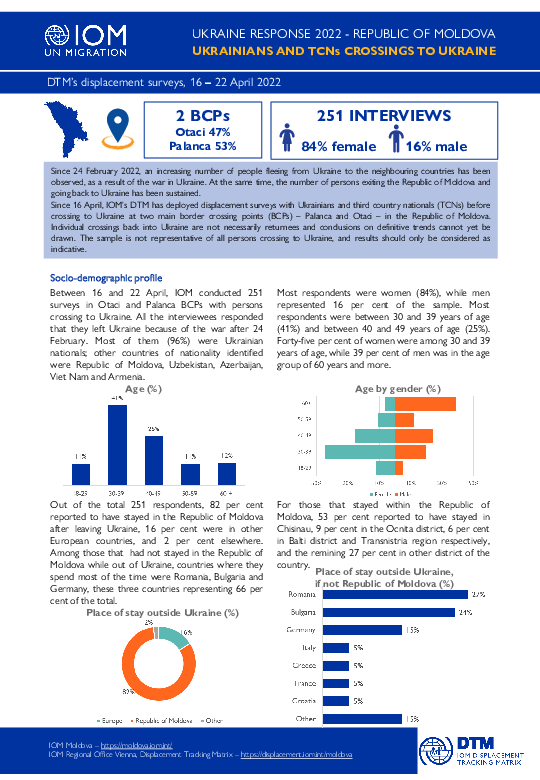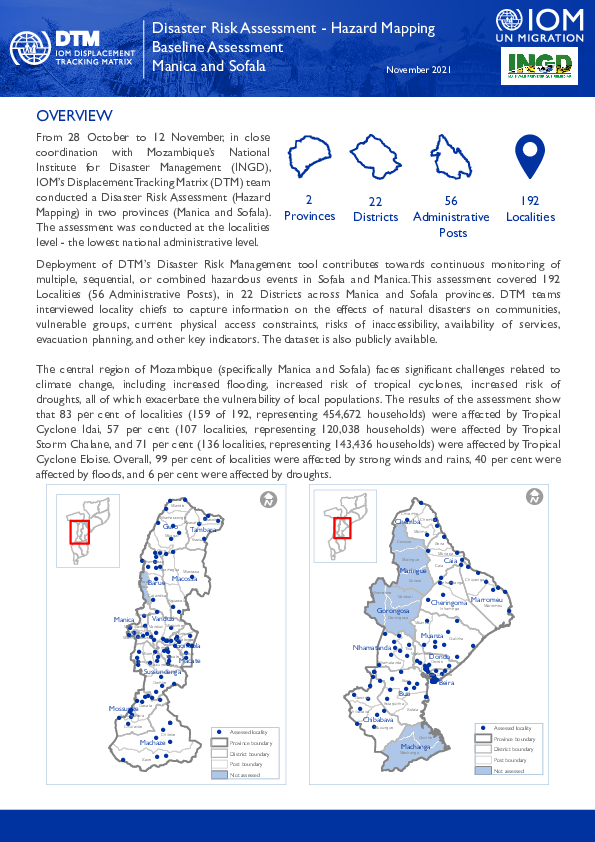-
Countries
-
Data and Analysis
-
Special Focus
-
Crisis Responses

Contact
DTM Europe, DTMMediterranean@iom.int
Language
English
Location
Republic of Moldova
Period Covered
Apr 16 2022
Apr 22 2022
Activity
- Survey
- Return Intention
Since 24 February 2022, an increasing number of people fleeing from Ukraine to the neighbouring countries has been observed, as a result of the war in Ukraine. At the same time, the number of persons exiting the Republic of Moldova and going back to Ukraine has been sustained.
Since 16 April, IOM’s DTM has deployed displacement surveys with Ukrainians and third country nationals (TCNs) before crossing to Ukraine at two main border crossing points (BCPs) – Palanca and Otaci – in the Republic of Moldova. Individual crossings back into Ukraine are not necessarily returnees and conclusions on definitive trends cannot yet be drawn. The sample is not representative of all persons crossing to Ukraine, and results should only be considered as indicative.

Contact
DTM Europe, DTMMediterranean@iom.int
Language
English
Location
Republic of Moldova
Period Covered
Mar 09 2022
Apr 22 2022
Activity
- Survey
- Flow Monitoring
Since 24 February 2022, increasing numbers of refugees and third-country nationals entering the Republic of Moldova have been registered amid the war in Ukraine. As of 22 April, Moldovan authorities have reported 430,226 arrivals from Ukraine, of whom 393,192 are Ukrainian refugees and 37,034 third-country nationals.
This is the third fact sheet that summarizes the results of displacement surveys initiated by IOM in partnership with UN Women to assess the needs and vulnerabilities of refugees and third-countries nationals fleeing into the Republic of Moldova from Ukraine. This report presents an analysis based on the 9,978 interviews conducted between 9 March and 22 April 2022, out of which 9,045 were interviewed at four Moldovan border crossing points – Otaci and Palanca (at entry), and Leuseni and Giurgiulesti (at exit) – as well as in three transit locations – MoldExpo, the Ukrainian Consulate, and a bus station in Chisinau, the capital city. Additionally, 933 interviews were conducted in temporary placement centres and private accommodations, using an extended questionnaire based on the Displacement Tracking Matrix tool.
Contact
DTM Mozambique, DTMMozambique@iom.int
Location
Mozambique
Activity
- Mobility Tracking
- Baseline Assessment
Period Covered
Oct 28 2021 -Nov 12 2021
A baseline assessment is a sub-component of mobility tracking. It aims to collect data on IDP, migrant or returnee population presence in a defined administrative area of the country.
Population Groups
Survey Methodology
Unit of Analysis Or Observation
Type of Survey or Assessment
Keywords
Geographical Scope
Administrative boundaries with available data
The current dataset covers the following administrative boundaries

Contact
DTM South Sudan, SouthSudanDTM@iom.int
Language
English
Location
South Sudan
Period Covered
Dec 01 2021
Dec 31 2021
Activity
- Registration
- Biometric Registration
The International Organization for Migration's Displacement Tracking Matrix (IOM DTM) in South Sudan maintains Biometric Registration database in Naivasha IDP Camp. During maintenance IOM DTM carries out registration of newborn babies, replacement of lost cards, merging of households that have requested to be included in under one household and handling of referred protection cases from protection partners. In December 2021, the population of Naivasha IDP Camp comprised a total of 11,383 individuals (3,359 households).

Contact
DTM South Sudan, SouthSudanDTM@iom.int
Language
English
Location
South Sudan
Period Covered
Dec 01 2021
Dec 31 2021
Activity
- Registration
- Biometric Registration
The International Organization for Migration's Displacement Tracking Matrix (IOM DTM) in South Sudan maintains Biometric Registration database in Malakal Protection of Civilian Site (PoC). During maintainance IOM carries out registration of newborn babies, replacement of lost cards, merging of households that have requested to be included under one household and handling of referred protection cases from protection partners. As of December 2021, the population of the four sectors comprised a total of 31,094 individuals (9,032 households).

Contact
DTM South Sudan, SouthSudanDTM@iom.int
Language
English
Location
South Sudan
Period Covered
Dec 01 2021
Dec 31 2021
Activity
- Registration
- Biometric Registration
The International Organization for Migration's Displacement Tracking Matrix (IOM DTM) in South Sudan maintains the Biometric Registration database in both Juba IDP Site 1 and Juba IDP Site 3. During maintenance IOM DTM carries out registration of newborn babies, replacement of lost cards, merging of households that have requested to be included in under one household and handling of referred protection cases from protection partners. In December 2021 the population of IDPs in the two sites comprised a total of 31,401 individuals (9,297 households).

Contact
DTM South Sudan, SouthSudanDTM@iom.int
Language
English
Location
South Sudan
Period Covered
Dec 01 2021
Dec 31 2021
Activity
- Registration
- Biometric Registration
The International Organization for Migration's Displacement Tracking Matrix (IOM DTM) in South Sudan maintains the Biometric Registration database in Bor IDP Site. During maintenance IOM DTM carries out registration of newborn babies, replacement of lost cards, merging of households that have requested to be included in under one household and handling of referred protection cases from protection partners. In December 2021 the population of Bor IDP Site comprised a total of 2,687 individuals (1,047 households).

Contact
DTM South Sudan, SouthSudanDTM@iom.int
Language
English
Location
South Sudan
Period Covered
Dec 01 2021
Dec 31 2021
Activity
- Registration
- Biometric Registration
The International Organization for Migration's Displacement Tracking Matrix (IOM DTM) in South Sudan maintains the Biometric Registration database in Bentiu IDP Camp (previously Protection of Civilian Site - PoC). During maintenance IOM DTM carries out registration of newborn babies, replacement of lost cards, merging of households that have requested to be included under one household and handling of referred protection cases from protection partners. In December 2021 the population of IDPs in the five sectors comprised a total of 134,771 individuals (30,723 households).

Contact
DTM Mozambique, DTMMozambique@iom.int
Language
English
Location
Mozambique
Period Covered
Oct 28 2021
May 12 2022
Activity
- Baseline Assessment
From 28 October to 12 November, in close coordination with Mozambique’s National Institute for Disaster Management (INGD), IOM’s Displacement Tracking Matrix (DTM) team conducted a Disaster Risk Assessment (Hazard Mapping) in two provinces (Manica and Sofala). The assessment was conducted at the localities level - the lowest national administrative level.
Deployment of DTM’s Disaster Risk Management tool contributes towards continuous monitoring of multiple, sequential, or combined hazardous events in Sofala and Manica.This assessment covered 192 Localities (56 Administrative Posts), in 22 Districts across Manica and Sofala provinces. DTM teams interviewed locality chiefs to capture information on the effects of natural disasters on communities, vulnerable groups, current physical access constraints, risks of inaccessibility, availability of services, evacuation planning, and other key indicators. The dataset is also publicly available.

Contact
DTM Nigeria, AllUsersInDTMNigeria@iom.int
Language
English
Location
Nigeria
Period Covered
Apr 25 2022
May 01 2022
Activity
- Mobility Tracking
- Event Tracking
The DTM Emergency Tracking Tool (ETT) is deployed to track and to collect information on large and sudden population movements, provide frequent updates on the scale of displacement and quantify the affected population when needed. As a sub-component of the Mobility Tracking methodology in Nigeria. ETT utilises direct observation and a broad network of key informants to capture best estimates of the affected population per location, enabling targeted humanitarian response planning.
Between 25 April and 01 May 2022, a total of 2,968 movements were recorded in Adamawa and Borno States. The recorded movements consisted of 2,846 arrivals and 122 departures. Arrivals were recorded at locations in Askira/Uba, Bama, Biu, Damboa, Gwoza, Kala/Balge, Monguno and Ngala Local Government Areas (LGAs) of the most conflict-affected state of Borno and in Fufore, Gombi, Hong, Lamurde, Maiha, Michika, Mubi South, Song, Yola North and Yola South LGAs of Adamawa State.
Departures were recorded in Askira/Uba LGA of Borno State and in Fufore, Gombi, Hong, Maiha and Yola North LGAs of Adamawa State.
ETT assessments identified the following movement triggers: voluntary relocation (839 individuals or 28%), military operations (646 individuals or 22%), poor living conditions (422 individuals or 14%), conflicts/attacks (361 individuals or 12%), government-assisted relocation (275 individuals or 9%), fear of attacks (190 individuals or 7%), improved security (177 individuals or 6%) and seasonal farming (58 individuals or 2%).